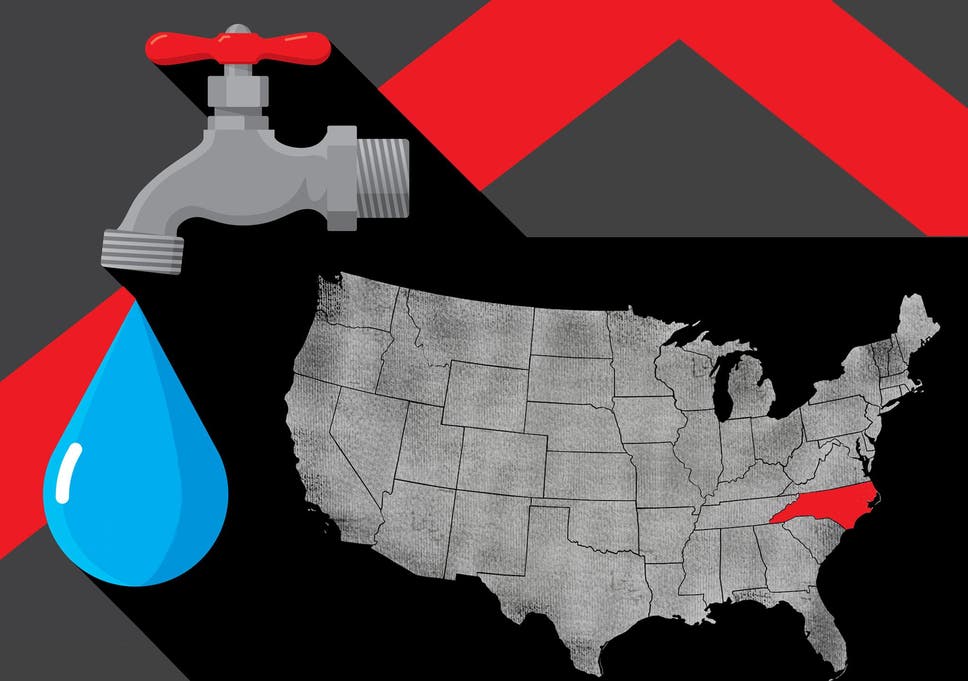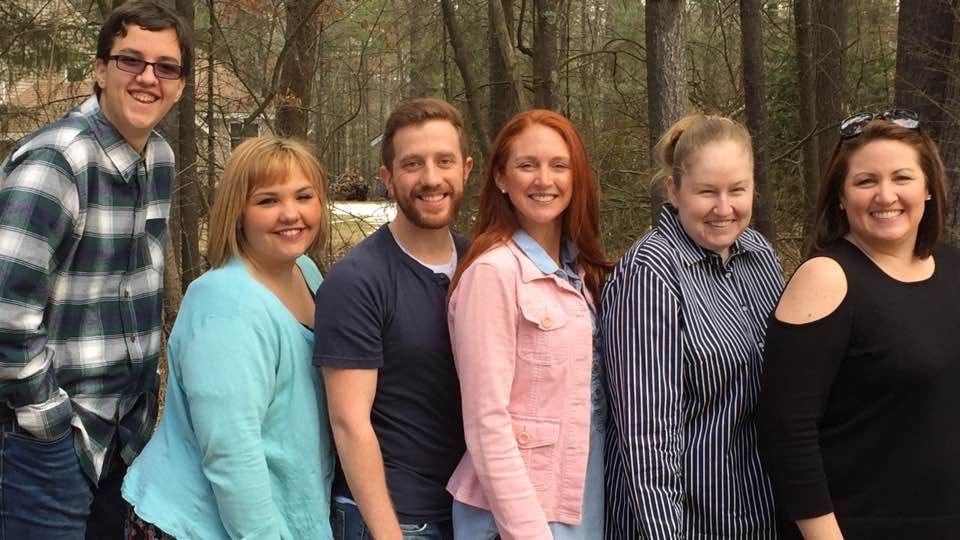
Three years after moving to North Carolina, Emily Donovan says she believes the water in her taps began to slowly turn her husband blind.
Downstream from the Fayetteville Works plant — a sprawling compound formerly run by Dupont near the Cape Fear River where chemical products used for things like flame retardants and anti-stick pan coatings are made — Donovan’s husband had developed a cancerous tumour on his optic nerve that doctors had a hard time explaining.
She says that one of the things that struck her about her husband’s 2013 diagnosis was that he has a biological twin brother, who had no signs of a similar issue. And, as time wore on, she began to notice what she felt was an unusual amount of illnesses in her neighbourhood and community.
So, when she read a newspaper article several years later showing that the chemical plant, which sits right upon the water supply, had been discharging high levels of polyfluoroalklyl (PFAS) chemicals, her ears pricked up — and, after learning about the growing evidence that those same chemicals can lead to cancer, she figured she found her culprit.
“I am a youth director at the church in the area, and a fair amount of my students are praying almost every week for someone in the family who is seriously ill,” Donovan tells The Independent, listing illnesses afflicting the community including blood, brain and gal bladder cancer, that she believes are a result of the chemicals. “These are my peers. These are people under 50 suffering from very serious illnesses. This is just not normal.”
It’s a hypothesis that has gotten renewed support this year with the release of a new study by the Environmental Working Group (EWG), which for the first time found the toxic PFAS chemicals in the drinking water supplies of dozens of US cities, including major metropolitan areas. Atop that list sits New Brunswick County, North Carolina, where a group run in part by Donovan found the chemical far above the 70 parts-per-trillion (ppt) limit recommended by the Environmental Protection Agency (EPA) — at a whopping 185.9 ppt.
PFAS chemicals are, generally speaking, nearly ubiquitous in the United States and in much of the developed world.
First produced commercially in the 1940s, the chemical family includes thousands of individual forms, and have been used to manufacture a range of products including firefighting foams, hazmat suits, as well as brand name consumer products like Scotchgard and Teflon.
And, in the 80 years since their creation, the chemicals — known as "forever chemicals” because they do not easily break down when they seep into water, creating what some have called "toxic soup" — have been creeping into the bodies of Americans everywhere, with the Centres for Disease Control and Prevention reporting that most people in the country have one or more specific PFAS chemical in their body (in the UK, as in the US, the chemicals are found in many products and efforts to convince the government to regulate have been similarly slow or non-existent).
The new EWG report shows that that ubiquity may be even more profound than previously realised. The study took samples from 44 locations in 31 states and the District of Columbia, and found that just one had no PFAS in its water at all. The test, to some degree, also exceeded past testing in another way beyond the number of locations tested, with 30 different types of PFAS compounds being tested for as opposed to two that are normally checked.
Sydney Evans, an analyst with EWG who worked on the study, says that they believe that these chemicals are likely in every surface water in America, and that a major problem facing efforts to locate troublesome locations exists in the sheer number of potential chemical compounds in the PFAS family — researchers don’t have thousands of different tests developed, she says.
“The broader issue right now is we don’t know… we can’t test for something when we don’t know what it is,” Evans says. “It’s not just a matter of getting a microscope and looking at it.”
Those tests have been developed over time, which tracks simultaneously with the growing body of evidence in recent years suggesting potentially dire health consequences.
The chemical compounds could have major impacts on the health of communities in the United States including cancer and thyroid issues, studies of animals suggest, made even more worrisome by the long amount of time the compounds stay in the human body.
"PFAS chemicals are some of the most widespread, highly toxic and extraordinarily persistent chemicals known to man. And, they're among the largest public health threats of any chemical pollutants that we know about," Erik Olson, a senior strategic director for the Natural Resources Defence Council, says.
Nearly 800 miles away from New Brunswick County, North Carolina, New Hampshire state legislator Nancy Murphy says her community, too, has seen an unusual amount of illnesses that she believes are caused by a local factory now run by the multinational French company Saint-Gobain. The company admits there are PFOAs in 'certain groundwaters' near its Merrimack facility but denies manufacturing them.
Murphy says that her own household shows the range of worrying health impacts that might come from the chemicals, with three of her six adult children displaying unusual medical conditions for their ages and lifestyle. Her youngest has an overactive thyroid condition known as Graves disease, while another has an underactive thyroid. Yet another has very high cholesterol that baffles doctors because he is training for a marathon.
And, like in North Carolina, Murphy says she sees unusual rates of illness in the town of Merrimack, with clusters of cancer in neighbourhoods raising alarms.
“There’s a number of things that just don’t make sense. Could they be caused by other things? Yes, they could. But, given the fact that my children don’t share anything but an address… it’s hard not to make the connection,” Murphy says, referring to the fact that three of her six children are adopted so a shared biological cause is out of the question.
So far, the EPA has declined to officially classify the compounds as carcinogenic, even as the World Health Organisation’s International Agency for Research on Cancer has classified at least one of the compounds, known as PFOA, as “possibly carcinogenic to humans”.

In 2006, the agency asked companies to stop using PFOA, leading to eight major companies announcing they would stop voluntarily, and did so by 2015, leading to a 40 per cent decrease in blood PFOA in a decade’s time.
Still, larger efforts to curb the regulate and test for the chemicals have been thwarted in local state houses and Washington by powerful lobbying groups.
That influence effort includes, for instance, Dupont — one of the world's largest chemical manufacturers, that ran the North Carolina plant before spinning off to the current occupant of the compound, Chemours — which listed dozens of PFAS-related bills or concerns as targets of its lobbying in Washington and racked up a bill of $5.9 million that year. That investment also turns out to be the least the company, which was named DowDupont last year before breaking up into three groupings, spent on lobbying throughout the past decade, having spent a high of $15.88 million in 2017. And, during the last presidential election cycle, the company and its employees donated a staggering $2.2 million to candidates and party committees, with Hillary Clinton receiving the most of any individual candidate from individuals associated with the company at $67,418, according to campaign finance data analysed by the Centre for Responsive Politics.
And none of that includes lobbying efforts undertaken at the state level across the country, including in New Hampshire, where Murphy says she regularly sees lobbyists from chemical industry giants like 3M, Saint-Gobain (which owns the plant near her home) or the American Chemistry Council at meetings of the state legislature she attends.
"I see them in every one of our hearings. They work to thwart things that are going to impact profit," Murphy says. "But I want to know, what's the value of human life?"
In response to questions from this article, Chemours said that they have invested $100 million into their North Carolina plant for "state-of-the-art emission control technology" that first began to be used in December, and said it is committed to reducing the emission of the PFAS chemical known as "HFPO-DA" and others by "at least 99 per cent" (they also suggested that scientific evidence on the health risks of HFPO-DA are not as bad as feared).
A spokesman for DuPont noted that it no longer runs the North Carolina plant, but did not comment further when asked about the company's lobbying portfolio.
A Saint-Gobain spokesman told The Independent in a statement that the company has "taken a leadership position in the community, working very closely and cooperatively with the state of New Hampshire".
"Saint-Gobain Performance Plastics is part of a company with a 354-year-old history. Our longevity comes in part because we recognise the importance of being good stewards and partners to the communities where our people live and work," the spokesperson, Dina Pokedoff, said.
Despite those claims, a press release on the New Hampshire Department of Environmental Services notes that an investigation in 2018 "concluded that the facility continues to have small emissions of PFAS compounds which could contribute to the existing groundwater exceedances of the current state of Ambient Groundwater Quality Standard (AGQS) of 70 parts per trillion (ppt) for perfluorooctanoic acid (PFOA), 70 ppt for perfluorooctanesulfonic acid (PFOS) and 70 ppt for PFOA and PFOS combined".
Lobbying and donations or not, it appears unlikely that President Donald Trump would consider much by way of regulation, even if a bill managed to land on his desk, given his administration's assault on water and environmental protections in the US (including a rule announced just this week that would strip Obama-era clean water protections from smaller waterways across the country).
“It’s a full scale assault on all environmental regulations across the board. I can’t think of anything where they’ve strengthened anything,” says Pat Parenteau, a professor of law at the Vermont Law School who focuses on environmental law, describing the Trump administration’s record on the environment.
Of PFAS specifically, Parenteau noted that there is litigation and some action in Congress — the House passed a bill to regulate the chemicals this year, but the Senate has not taken it up — but said nothing has been done in the existing framework. “You’re not seeing the EPA convene a task force to really come up with new standards to get them in place and get them enforced.”
Donnelly says that she hopes the new Environmental Working Group study — which she helped to conduct by sending in water samples from a school in her county — will help to illuminate the health risks of the PFAS chemicals.
So far, she has managed to attract a considerable audience, and has testified before Congress right alongside actor Mark Ruffalo, who has released a movie about the dangers of PFAS chemicals.
In the end, Donnely says her husband was the beneficiary of a miracle, after his tumour was removed from his optic nerve by a surgeon, he somehow still managed to come out with 20/20 vision.
She says, though, that she doesn’t think starting with the question of how to prove adverse impacts from the chemicals is the right approach. Instead, she says, the companies doing the polluting should prove they aren’t doing harm.
“What I know is we were overexposed. We were clearly overexposed by these chemicals. Right now science can’t confirm if those exposures are the reason why we’re getting sick. So, that’s the frustrating part, is that there is an odd sense of too many illnesses,” she says. “That’s what’s broken about our system — we shouldn’t be exposed to this stuff up front, and then asked if we’re safe later.”







